
Capital Gains Taxes on a Second Home: When Do You Have to Pay?
Selling your second home can come with more than just sentimental value, but may also come with a hefty tax bill. Unlike your primary residence, second homes don’t automatically qualify for the IRS’s capital gains exclusion, meaning you could owe taxes on the profit from your sale. Here’s what you need to know about when those taxes apply, how they’re calculated, and smart ways to reduce what you owe
What Is Considered a Second Home?
To know how the tax rules apply, you must distinguish your primary residence from a second home.
Distinguishing Primary vs. Secondary Residence
Your primary residence is where you live most of the time: where you are registered to vote, receive mail, hold your driver’s license, etc. A second home is any property you own but do not occupy as your primary residence.
Impact of Rental Use
If you rent out the property part-time, it may be classified more like an investment or rental property, rather than just a second home. In those circumstances:
- You may take depreciation deductions.
- You must allocate personal use vs. rental days.
- On sale, depreciation recapture and rental property rules will apply.
Your tax outcome depends heavily on the number of days you rented the home versus the number of days you personally used it. The IRS Publication 523: Selling Your Home explains these distinctions in more detail.
How Capital Gains Taxes Work on Property
Short-Term vs. Long-Term Capital Gains
If you sell a property within one year of purchase, the gain is considered short-term and taxed at ordinary income tax rates (which may be as high as 37%, depending on your tax bracket).
If you hold it for more than one year, the gain is long-term and taxed at lower rates (0%, 15%, or 20%, depending on your income).

Because many second homes are held for multiple years, long-term capital gains rates typically apply. You can review the rate tables in TurboTax’s guide to second home taxes.
The IRS Exclusion Rule for Primary Residences
Under Section 121, homeowners may exclude up to $250,000 (or $500,000 if married filing jointly) of gain on the sale of a primary residence, provided:
- You owned the home for at least 2 of the last 5 years, and
- You lived in it as your main home for at least 2 of the last 5 years (not necessarily consecutively)
Unfortunately, this exclusion typically doesn’t apply to second homes or investment properties unless you convert the property into your primary residence and meet those requirements. If your second home becomes your primary residence before selling, you might qualify for a partial or full exclusion under IRS Section 121.
When You’ll Owe Capital Gains on a Second Home
Sales That Trigger Taxes
You will owe capital gains tax when you sell your second home and your net sale proceeds exceed your adjusted basis (what you paid plus improvements minus depreciation, if any). Because the Section 121 exclusion typically doesn’t apply, the gain is generally taxable in full.
How Your Usage Affects Your Tax Liability
Your history of use matters:
- If you never lived in the property as your main home and never rented it, it's a “pure” second home.
- If you converted it into your primary home and satisfy Section 121 rules, you might exclude some or all gain.
- If you rented it, you need to divide it between personal use and rental use. Part of the gain may be taxed differently; depreciation recapture may apply.
The allocation is based on the number of days used personally versus rented, as well as the duration of each period. You can learn more about property use rules and ownership in the Giving Property FAQ.
Calculating Your Gain (and What You Can Deduct)

Cost Basis, Improvements, and Selling Costs
To compute your gain:
- Start with your original cost
- Add the cost of capital improvements (those that add value or extend life, e.g. an addition, new roof)
- Subtract any depreciation claimed (if treated as rental) → gives your adjusted basis
Then
- Subtract selling costs (commissions, closing costs, legal fees) from the sale price.
- Subtract your adjusted basis. → The result is your capital gain.
→ The result is your capital gain. Example: Buy for $200,000; add $30,000 in improvements; take $10,000 depreciation if rented → basis = $220,000. Sell for $300,000 minus $15,000 in selling costs gives a net $285,000 → gain = $65,000
What You Can Deduct Against the Gain
You may reduce the taxable gain by:
- Selling expenses (commissions, legal fees)
- Closing costs allocable to selling
- Capital improvements in your adjusted basis
- (If rental) Depreciation recapture will increase tax on the gain, so that’s not a deduction but an additional tax burden
Repairs or routine maintenance don’t qualify as capital improvements. And if you depreciated the property while renting, that depreciation must be “recaptured” and taxed.
Reducing or Avoiding Capital Gains
Holding Strategies
- Hold longer than one year to qualify for lower long-term capital gains rates.
- Convert to your primary residence and live there for two of the last five years to qualify for a Section 121 exclusion (though timing and depreciation can complicate this).
- Time your sale to prevent the gain from pushing you into a higher tax bracket.
1031 Like-Kind Exchanges
If your second home is treated as an investment or rental, you may be able to use a 1031 exchange to defer taxes by exchanging it for a “like-kind” property. But since the Tax Cuts and Jobs Act, 1031 applies only to investment real property, not personal residences. So this strategy only applies if the property qualifies as an investment.
Charitable Donations / Gifts

Donating your second home to a qualified nonprofit can help you avoid capital gains taxes altogether. By donating appreciated property, you:
- Eliminate capital gains tax on the sale,
- Receive a fair market value charitable deduction, and
- Create meaningful impact for a cause you care about.
Through Giving Property, donors can give land, condos, or other real estate to support their favorite charity while simplifying the sales process. Visit the Real Estate Donation Guide to see how property gifts can help you save on taxes and make a difference.